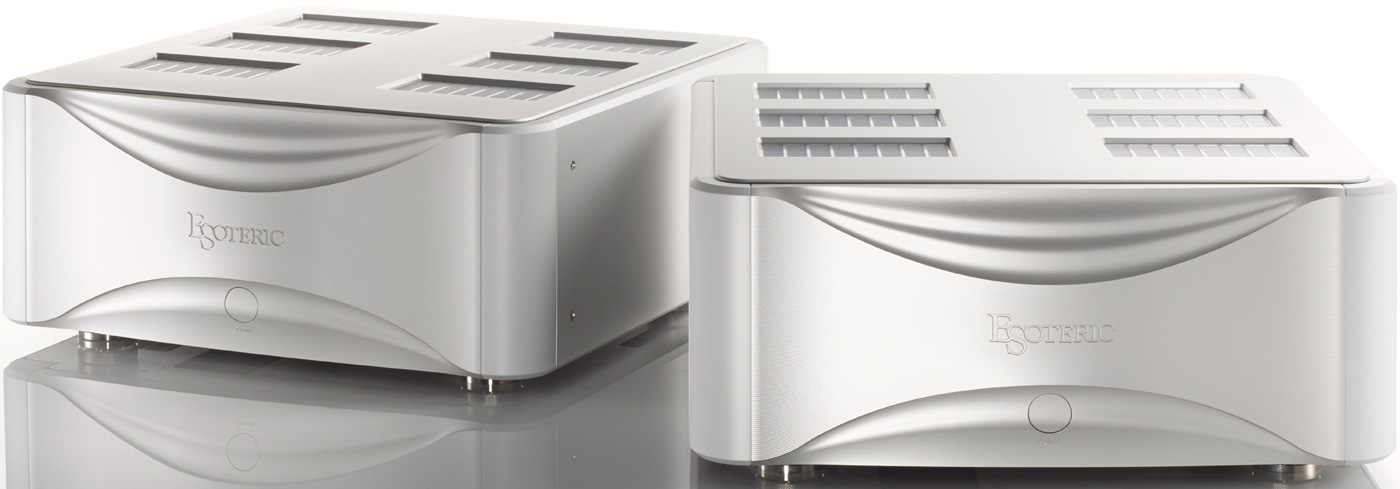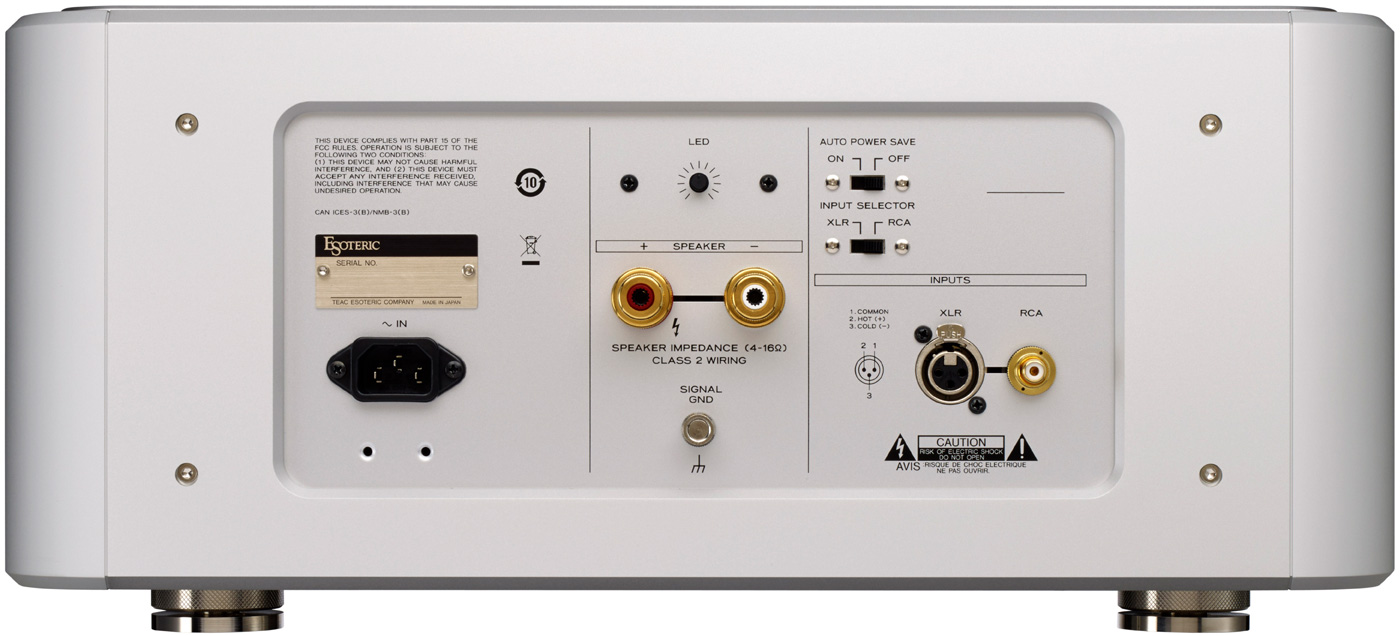Dancing Together
The Esoteric C1 and M1 are highly synergistic. I reviewed each with other components, but together they are superlative at bringing out the subtle nuances of any piece of music. My initial serious listening sessions were with the duo operating together in the configuration described above.
It’s necessary at this time to provide some context. From the very first note on my first listen, before the amps had even properly warmed up, the Esoteric Grandioso C1 and M1 sounded excellent. Instruments were natural in every respect, slam was powerful, pace was very good and tonality was spot-on. In fact, within 48 hours everything sounded so good I started thinking that I would need to find something to focus on to make this review meaningful – I couldn’t just say that the C1 and M1 are “fabulous.” Over the course of the next few days I decided that my review would focus on the emotional impact created by the C1 and M1. To me, this is the highest compliment I can pay to a component or system – it is so good that I only have to focus on the emotional impact it creates and can forget about “technical” things like detail, slam, extension, tonality and soundstaging.
One of the tracks I use to evaluate a component’s ability to convey raw emotion is Luciano Pavarotti’s live rendition of Rondine al Nido from The Three Tenors In Concert disc. It is sung in Italian – which I do not speak – so I actually have no idea what the words are. However, Pavarotti’s delivery is so emotionally nuanced and powerful that audiences find it very moving. When listening to this recording in the past I had always appreciated how he conveyed emotion through his performance, but when listening with the Esoteric C1 and M1 in the system I actually found myself getting tears in my eyes. To see if I was just being an emotional wimp, I played this same piece in listening sessions with two separate groups of four listeners. In one session one of my guests was tearing up and in the other session two actually confessed that they had to consciously control the desire to do cry. Granted, I’d made some very important tweaks to make my listening room better, but the new room only facilitated what the C1 and M1 reproduced.
One of my favorite wintertime classical pieces is Tchaikovsky’s Daydreams On A Wintry Road from Symphony No. 1 in G Minor, “Winter Daydreams.” This is a piece of music that has both slower-moving quiet passages as well as powerful dynamic passages. The dynamic passages rightfully demand power and pace, but sometimes when you get the power and pace right you lose the emotive aspects of the slow-moving quiet passages. Not so with the C1/M1 combo. The balance between these two aspects of the music is superb, with slower passages getting the benefit of a luxurious presentation, while the fast powerful passages have the pace and power, but without any loss of nuance, with each note having an attack, body and decay, even when the orchestra is playing fast and powerfully.
A piece of jazz-rock that helps me identify equipment that brings out the emotion of recordings is Blood, Sweat and Tears’ rendition of “God Bless The Child,” a piece written by Billie Holiday and Arthur Herzog Jr., and appropriately included in the list of the Songs Of The Century by the National Endowment for the Arts and the RIAA. I have a hard time choosing between Billie Holiday’s version and the BST version, but find the combination of brass, organ, piano, drums and David Clayton Thomas’ voice to perfectly convey the sentiment of the lyrics. In my system, the instruments have always sounded excellent, but with the C1/M1 in play David Clayton Thomas’s voice gained expressiveness and emotion, adding significant power to the musical presentation.
Another piece of “popular” music that I use to ascertain a component’s ability to convey emotion is Löwen and Navarro’s “Oh Mary.” Similar to my experience with BST’s version of “God Bless The Child,”the voices were more emotive and added to the impact of the music. In addition, it seemed that each note hung in the air, from attack to final decay, without slowing the pace of the music.
I have heard in the past that Esoteric voices the Grandioso components to really shine on classical music. As you can see from my comments above, the fabulous results are not limited to the classical genre. However, if you are a classical music aficionado, these components are a must-hear. In subsequent binges with purely classical music I found myself irresistibly involved in the musical experience in ways I rarely experience.
There were many changes affecting my listening room that I was not yet familiar with when I first installed the C1 and M1’s in my system. However, subsequent room adjustments showed that my initial experience with the C1 and M1’s was an accurate portrayal of the duo’s quality and voicing. As I tweaked the room the C1/M1 combo simply sounded a bit better at every step.
Dancing With Other Partners
After extended listening with the C1 and M1 working together, the first alternative configuration I tried was the M1’s without the C1. This alternative in turn was done in two versions. The first was to leave the Wavelet in the chain as a DAC, and using its room correction features. Preamp functions were instead handled by the $16,500, 3-piece Pass Labs XP-30 preamp. I’m sure there are others, but the XP-30 is one of the most neutral and detailed I have ever heard. Unlike preamps that sweeten the sound, it gives you what’s coming out of the source, and if you don’t like what comes out of the source you will not like the final sound unless your amps or speakers somehow compensate. Inserting the XP-30 in lieu of the C1 produced a highly detailed and dynamic sound, but there was definitely a noticeable loss of emotive nuance. After careful listening, I concluded that the $35,000 C1 carried each note to its final decay, while the XP-30, despite its amazing detail, did not. The effect of this was to make every note through the C1 fully expressive in its own right, but in a way that sounded wholistic, like listening live to a tight band in a good venue.
I next replaced the M1 monoblocks with my own Electrocompaniet Nemo monoblocks and reinserted the C1 preamp. I liked the resulting sound very much, but the sense of each note’s attack and decay was reduced. When I had some audiophile friends over listening to this configuration they all absolutely loved the sound, but when I then substituted the M1 for my Nemos they were amazed by the added nuance. Further experimentation with alternate configurations led me to the inescapable conclusion that the synergy between the C1 and M1’s is so strong that substituting another component for either simply fails to produce the superb musical result obtained when the C1 and M1’s are used together.
One thing I did not test was the built-in grounding system. Esoteric recommends that you use the provided grounding connections between the C1 and M1’s, but I obtained such great results I didn’t bother. In retrospect I should have tried the connections out, and I will do so if I ever get these fabulous components back for another listen.
Conclusions
When you review components that are this good you’re forced to get very picky and to focus on the few “weaknesses” of the component. What are these “weaknesses”, you ask? Well, I had to really work at coming up with one, and it requires careful explanation so that I convey it accurately. Let me start by stating an impression that I got when listening to rock music: some rock music sounded too “slow” to me. The fact that the C1/M1 develops the attack, body and decay of each note was fabulous with classical, jazz, audiophile vocals, etc.; but for me, it created an impression of sluggishness with 10% of the rock I listened to. Two of my regular listening buddies strongly disagreed with my assessment, stating that they thought that my own system creates a slightly “fast” pace to all music played through it. The most contentious debate on this point came when playing “Josie” from my hi-res version of Steely Dan’s Aja. The two listeners who were primarily “turntable and tubes” guys thought the rendition through the C1/M1 combo was perfect, whereas I and my other guest thought the pace should be faster. That’s it. That’s my only caveat about these over-the-top fabulous components. Don’t say I didn’t warn you lovers of Aja.
Really expensive high-end components can be hard to rate. Not so with the Esoteric C1 and M1. On classical, jazz and any vocal music the Esoteric combo is one of the most elite preamp/amp sets I’ve ever heard, easily in the top 1%. I’m tempted to say they are the absolute best, but there are several high-end “über” amplification components I have not heard. I would have purchased them if I had not just spent oodles of money rebuilding my music room, and perhaps some day I will ask Esoteric for another shot when I’ve restored my bank account.
Unreservedly recommended as can’t-go-wrong, rest-of-your-life components.
Copy editor: Dan Rubin
- ← Previous page
- (Page 2 of 2)



Hello could you please elaborate more on the amp hum and your lights? Where they on the same line? where the lines very close to one another? Do the amps need better shielding?
Thanks Pete
Great review Ed,…thank you for focusing on the musical experience and emotional aspects of what these units can do. I have the C-02 and A-02 combination and they are fantastic in their own right however the C1/dual-M1 configuration is definitely a destination-system plan for me if the stars were ever to align. Outstanding review!
A amp in this price range with this problem i will pass
Has nothing to do with the amp
It’s a good idea to connect the chassis together. You could use a 12 or 10AWG high quality wire for this. Their prices are typical excessive profit types, but well done for the excellent sound.